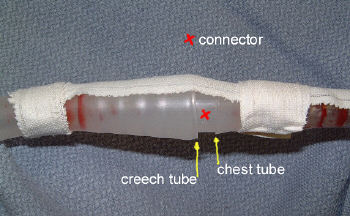Pneumothorax is typically diagnosed radiographically. Significant pneumothoraces show up on chest xray, and even small ones can be demonstrated with CT.
Typically, a known pneumothorax is followed with serial chest xrays. If patient condition permits, these should be performed using the classic technique (upright, PA, tube 72″ away). Unfortunately, physicians are used to ordering the chest xray as a bundle of both the PA and lateral views.
The lateral chest xray adds absolutely no useful information. The shoulder structures are in the way, and they obstruct a clear view of the lung apices, which is where the money is for detecting a simple pneumothorax. The xray below is of a patient with a small apical pneumothorax. There is no evidence of it on this lateral view.
Bottom line: only order PA views (or AP views in patients who can’t stand up) to follow simple pneumothoraces. Don’t fall into the trap of automatically ordering the lateral view as well!






